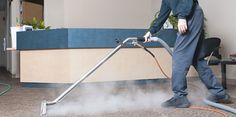Cleaning Up Commercial Premises After a Flood

Flood cleanup may seem to be a difficult process. It is essential to have a strategy for coping with the destruction. This article highlights some key guidelines for businesses’ post-flood cleanup.
Safety Should Be Your First Priority
Even though cleaning may be the first thing on your mind, you need to take precautions to keep yourself safe. The water might have been contaminated with wastewater or other toxins. Also, the building’s structural stability may have been compromised. If you suspect damage, have an expert assess the structure and make repairs before cleaning.
Dress appropriately before entering the building, regardless of whether there is water or not. It is necessary to wear long, thick trousers, goggles, an N-95 mask, and gloves. Keep all doors and windows open to eliminate odors from the working space.
Be Wary of the Risk of Electrocution
Before you begin cleaning up your flooded office building, you must also consider the risk of electrocution. Since electricity and water cannot cohabit, it is essential to cut off the power before entering the building. You may turn off the power in this manner if you can reach the main breaker or service panel without walking through the water. If not, request the utility provider to disconnect it at the meter.
The Cleaning Process
1. Remove Any Standing Water
Use buckets or pumps first, then a wet/dry vacuum.
2. Get Rid of Anything Unclean or Wet
Although it is difficult to part with belongings, you will have to discard the unsalvageable items. If they are not thoroughly cleaned, they may contain mold, viruses, and other infections. Avoid coming into contact with any non-salvageable items on your skin. Put them in garbage bags and place them at the curb. If sewage water got into them, they might need to be labeled and thrown away according to local standards.
Take pictures of any objects you have to throw away, since you may be able to include them in your insurance claim and be reimbursed for them.
3. Remove Silt and Mud
The next step is to remove as much mud and silt as possible. Use a hosepipe if needed.
4. Walls That Are Clean and Dry
Be quick, thorough, and cautious while dealing with the walls after a flood. The interior of the walls must be allowed to dry completely. The wall finishes and insulation should be removed to allow for the rapid removal of water and mud from the wall. Any wall finishes over the water line must be detached and destroyed. Due to the extreme capillary action, this might be up to 0.5 meters above the flood water level. If you see or feel wetness, cut the affected wall covering out and trash it.
The moisture meter is particularly useful in determining if the walls are sufficiently dry for re-sealing. If you have one, you will recognize moist walls immediately.
5. Clean Wood Surfaces and Floors
To avoid mildew, clean the floors and any woodwork vigorously within 48 hours of a flood. Use an ammonia-free detergent, a lot of hot water, and a disinfectant. Carefully remove dirt and silt from nooks and cracks.
Solid wood trim and wall finishes may be recovered with careful cleaning, disinfection, and refinishing. Many of the panels must be removed. The room should be heated to 50 degrees Fahrenheit to assist the mildewed wood in drying. As needed, use mildew-resistant paint. Also, replace wood that has deteriorated significantly.
6. Dry the Surfaces
Surfaces may be dried in 24-48 hours using heat and air. Infected things should be dried and thrown away so that mold or bacteria doesn’t grow on them.
The entire drying time will be affected by the construction materials utilized. It also depends on the amount and humidity. It may take weeks or even months to properly dry the building. This depends on the extent of the flooding and the building materials used.
7. Disinfect Every Room
Mold growth poses major risks if post-flood cleaning is not done appropriately. In addition to being unsightly, mold poses a serious health risk. As a result, you must properly disinfect every surface to limit the likelihood of mold growth in the future. You must also keep your working environment clean to avoid the transmission of illnesses.
Restoration 1 can help if you are unaware of what is required for post-flood cleanup of business property. You can count on our property restoration specialists and emergency responders to to assist you in the aftermath of a disaster. We have a lot of expertise and provide comprehensive commercial water damage restoration. For more information about our services, call restoration1.com today.





